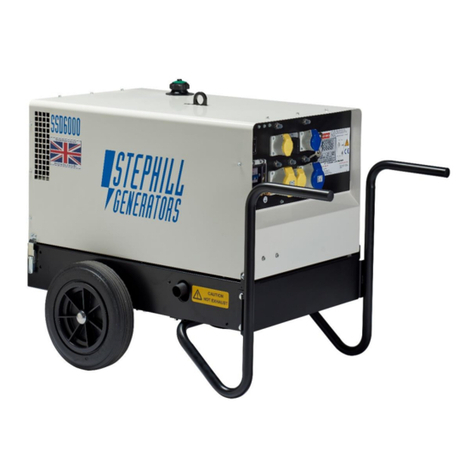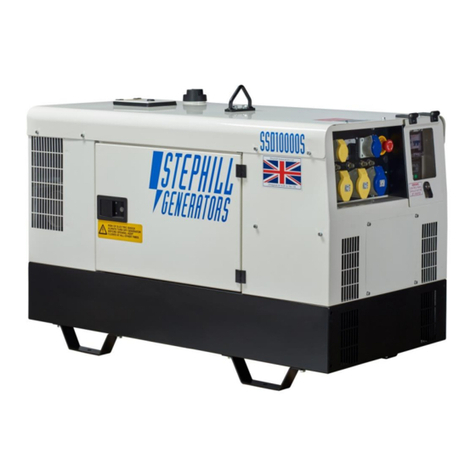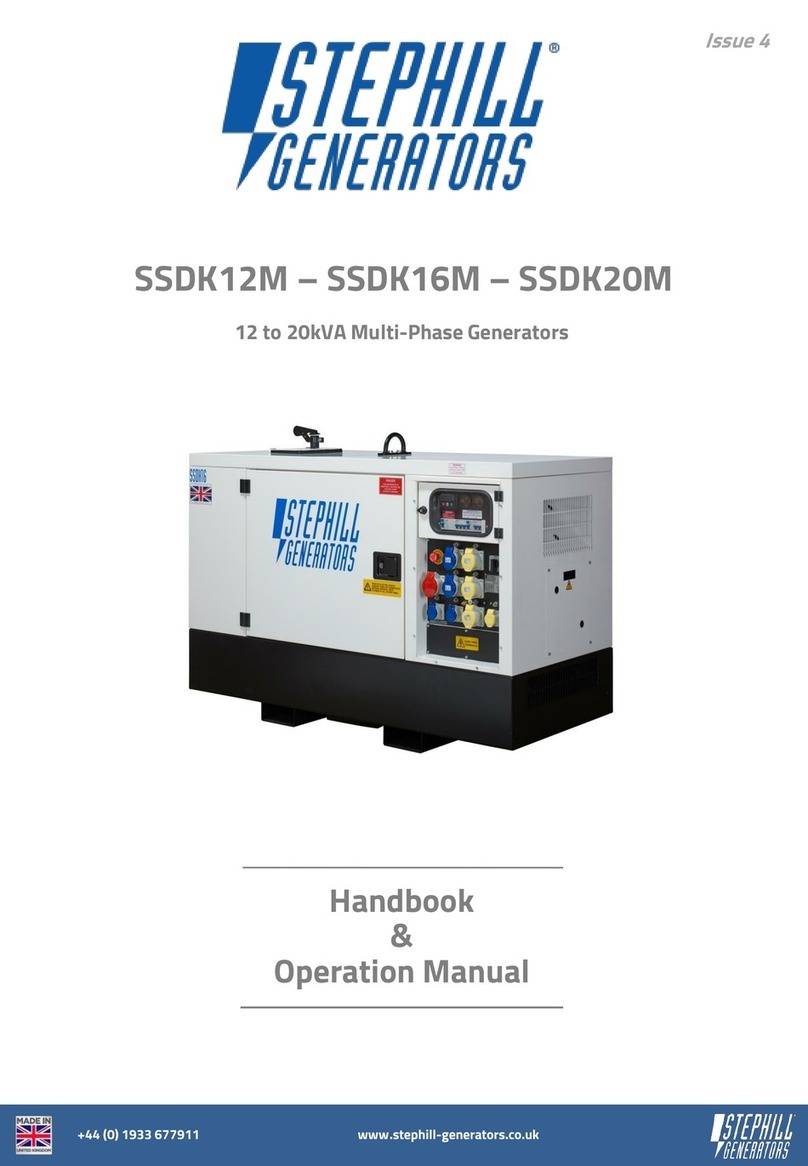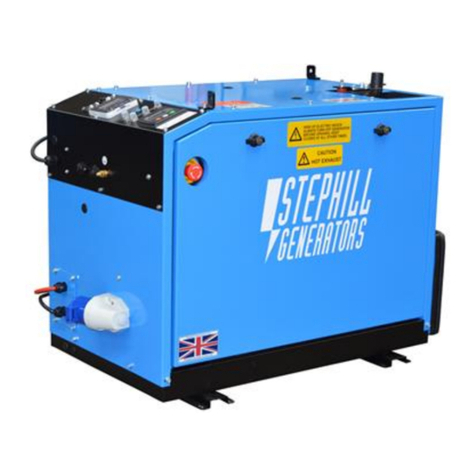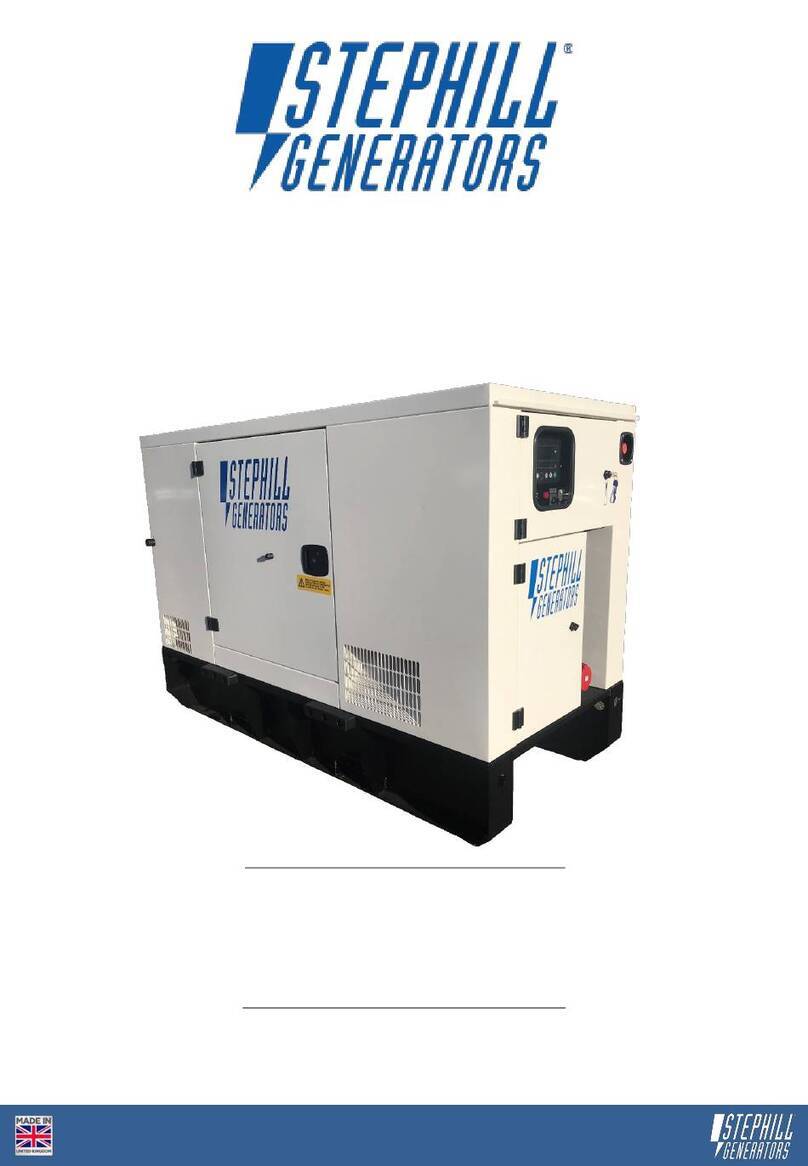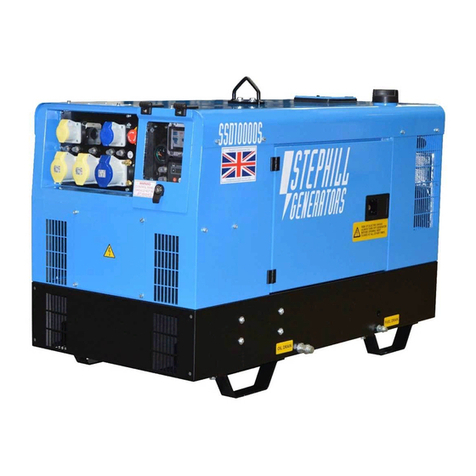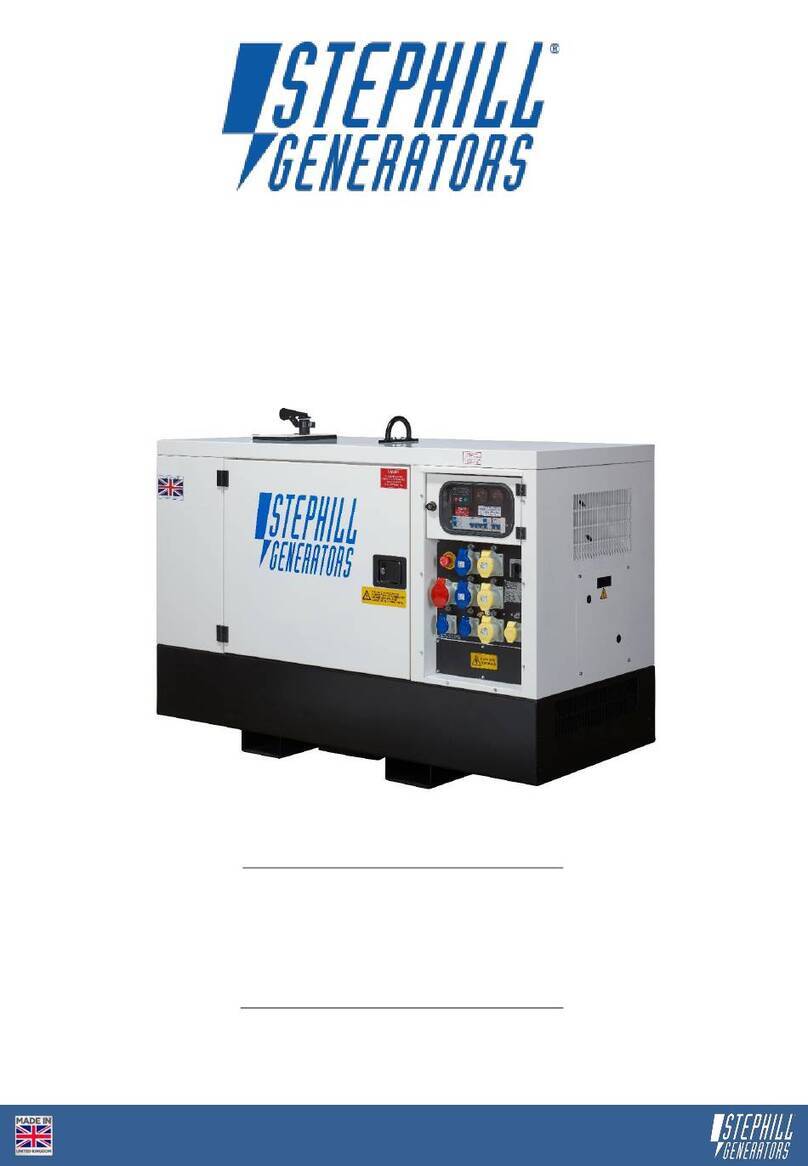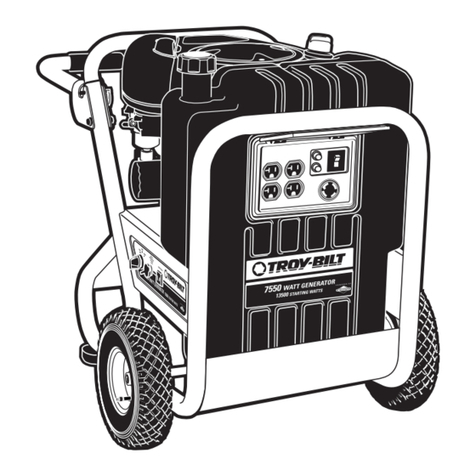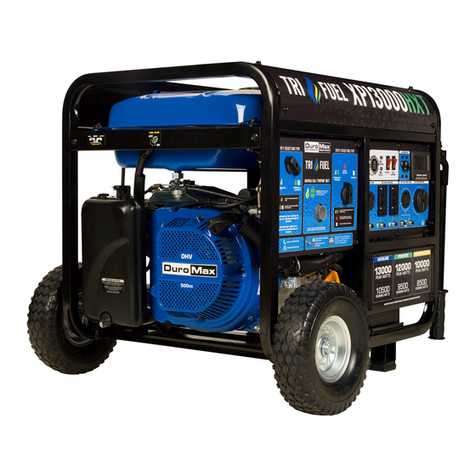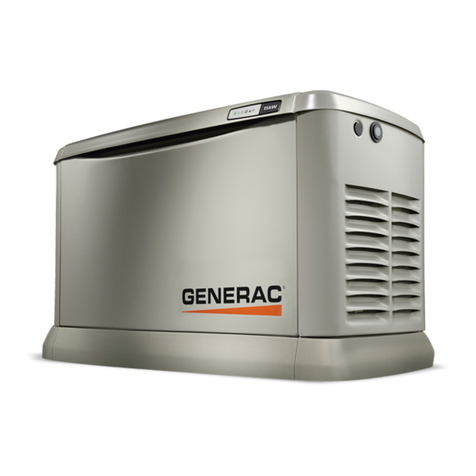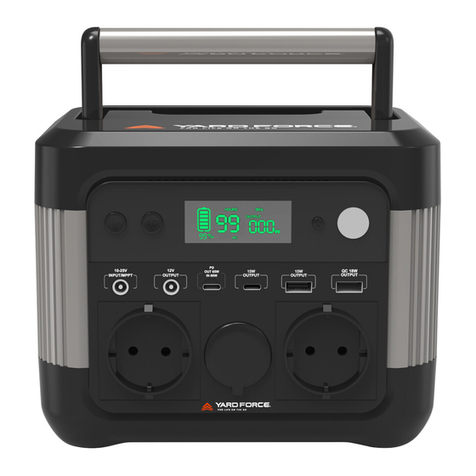Stephill SSDP120 User manual

Issue 1
SSDP120 Handbook
Deep Sea Electronics 7310
Stephill Generators Ltd
Wallis close
Park Farm South
Wellingborough
Tel : +44 (0)1933 677911
Fax : +44 (0)1933 677916
E-mail : info@stephill-generators.co.uk
Web : Web : www.stephill-generators.co.uk
Northants
NN8 6AG
DO NOT OPERATE THE GENERATOR BEFORE READING THIS MANUAL AND ENGINE
MANUFACTURER’S OWNER’S MANUAL AND WARNINGS.
THIS STEPHILL GENERATOR HAS BEEN DESIGNED TO PROVIDE SAFE AND EFFICIENT SERVICE IF
OPERATED AND MAINTAINED CORRECTLY.
MANY ACCIDENTS OCCUR THROUGH FAILURE TO ADHERE TO FUNDAMENTAL SAFETY
PROCEDURES.

Issue 1
Section
CONTENTS
Page
1.0
SPECIFICATION
1
2.0
GENERAL SAFETY
1
2.1
Warning signs
1
2.2
Safety hazards
1
3.0
POTENTIAL HAZARDS
1
3.1
Auxiliary power
1
3.2
Operating environment
1
3.3
Temperature range
1
3.4
Reference relative humidity
2
3.5
Reference barometric pressure
2
3.6
Flammable environment
2
3.7
Saline environment
2
4.0
SAFETY CONSIDERATIONS
2
4.1
General
2
4.2
Fuel
2
4.3
Bunded tank
2
4.4
Lubricating oil
2
4.5
Safe lifting
2
4.6
Earth connection
2
4.7
Fumes
2-3
4.8
Noise
3
4.9
Battery acid
3
4.10
Fire
3
4.11
Hot parts
3
5.0
OPERATING INSTRUCTIONS
3
5.1
Pre-Start checks
3
5.2
Emergency stop
3
5.3
Three way valve
3
5.4
Fuel lift pump priming
3
5.5
Control panel
3
5.6
Variable RCD ELR-3C
4
5.7
Hard wire terminals
4
5.8
Remote start terminals
4
5.9
Long term storage
4
6.0
DEEP SEA 7310 OPERATING INSTRUCTIONS
5
6.1
Controls
5-6
6.2
Manual mode
6
6.2.1
Waiting in manual mode
6
6.2.2
Starting sequence
6
6.2.3
Stopping sequence
7
6.3
Automatic mode
7
6.3.1
Waiting in auto mode
7
6.3.2
Starting sequence
7
6.3.3
Stopping sequence
7
6.4
Stop mode
7
6.5
Viewing the instrument pages
8
6.5.1
Status
8
6.5.2
Engine
9
6.5.3
Generator
9
6.5.4
CAN error messages
9
6.5.5
Viewing the event log
9-10
6.6
ECU overide
10-11
6.7
Engine
11
6.8
Generator
11
7.0
Protections
11
7.1
Alarms
11-12
7.1.1
Shutdown / electrical trip alarms
12
7.1.2
CAN alarms
12
7.2
Warnings
12-13
7.2.1
High current warning alarm
13
7.2.2
Shutdowns
13-14
7.2.3
IDMT alarm
14-15
7.2.4
Maintenance alarm
15-16
8.0
Fault finding 7310
16
9.0
Fault finding general
17
10.0
Spares
18
10.1
Perkins consumable spares
18
10.2
General spares
18-19
11.0
Service and maintenance
19
11.1
Engine service
19-20
11.2
Light load operation
20-21
11.3
Alternator service
21
12.0
Warranty
21
SSDP120 400V Wiring DSE 7310
22
Perkins 1100 Series Wiring ECU Deep Sea 7310
23
SSDP120 Exploded view
24
SSDP120 Canopy parts list
25

Issue 1
1
1 SPECIFICATION
GENERATOR SPECIFICATION SSDP120
Frequency
50Hz
Phase
3
Voltage
400/230
Standby Power (ESP)
117.1 kVA 93.7 kW
Prime Power (PRP)
106.1 kVA 84.9 kW
Engine
Perkins 1104D-E44TAG2 Engine
Emissions certified
EU (EU 97/68/EC Stage IIIa)
Displacement
4.4 Litres
Aspiration
Turbo charged
Alternator
105kVA Meccalte ECP 34-2S/4
AVR
DER 3Ø Electronic +/- 1%
Fuel tank capacity
470 Litres
Autonomy 100% load
19 Hours
24.5 Litres hour
Autonomy 75% load
24 Hours
19.8 Litres hour
Autonomy 50% load
35 Hours
13.2 Litres hour
LWA
92
DBA @ 7M
67
DBA @ 4M
72
DBA @ 1M
84
DIMENSIONS SSDP120
Length
Width
Height
Weight KG
SSDP120 Skid dry
2710
1100
1650
1944
SSDP120 Skid wet
2710
1100
1650
2335
SSDP120 Trailer dry
4500
1700
1960
2156
SSDP120 Trailer wet
4500
1700
1960
2547
2 GENERAL SAFETY
2.1 Warning signs
Warnings shown on the machine should be observed at all times. The warning signs should be
checked for legibility and any that have become damaged should be replaced.
2.2 Safety hazards
Do not climb on the generator, as dents may cause overheating of the acoustic lining.
It is important to keep the generator clean and well serviced, in particular keep all air vents / louvers
clear of debris to prevent poor performance or possible overheating and permanent damage to the
generator. Keep well clear of moving parts on the generator at all times.
3 POTENTIAL HAZARDS
3.1 Auxiliary power
The electricity produced by an engine driven Generator is very similar to mains electricity and should
be treated accordingly.
Do not remove covers and attempt to work on the Generator while the engine is running.
Check the rating and electrical safety of the load before connecting the Generator.
Equipment should never be connected that in total exceeds the specified rating of the Generator.
Installation of the generator as a standby or secondary power source should only be undertaken by a
fully qualified electrician using the appropriate means of isolation from the mains supply. Installation
must comply with all applicable laws and electrical codes.
3.2 Operating Environment
The Generator should always be operated on level ground.
3.3 Temperature Range
A temperature range between -15˚C and +50˚C are the normal limits of operation. Operating outside
the range will require additional modifications.

Issue 1
2
3.4 Reference Relative Humidity
The standard reference condition for relative humidity is 30%. Above this value the rated power must
be reduced.
3.5 Reference Barometric Pressure
The standard reference condition for total barometric pressure is 1 bar.
This corresponds to an altitude of approximately 100m. Above 100m the rated power must be
reduced.
3.6 Flammable Environment
Stephill Generators must not be used in a flammable environment.
3.7 Saline Environment
Operation of the machine in a saline environment will require additional corrosion protection.
4 SAFETY CONSIDERATIONS
4.1 General
All Stephill Generators comply with all the current EEC directives including:
2006/42/EC Machinery Directive
2000/14/EC Noise Emission in the Environment by Equipment for use Outdoors
2014/30/EU EMC Directive
2014/35/EU Low Voltage Directive
4.2 Fuel
Fuels and lubricants are a potential source of fire. Be careful not to spill fuel, clean up any spillages.
Inhalation or swallowing of Diesel should be avoided. If in doubt seek medical advice. All other forms
of contact are irritant and therefore should also be avoided. If skin contact is made wash with soap
and water.
4.3 Bunded tank
This generator is fitted with a secondary containment system (Bunded tank). The bund will need to be
inspected on a regular basis and drained accordingly. Any liquid drained from the Bund/Tank will
have to be treated as Oil/Fuel contaminated waste and disposed of accordingly.
Warning
Although this generator is fitted with a Bunded tank it is the duty of the owner to ensure that it meets
with Local/National regulations dependant on site location etc.
4.4 Lubricating Oil
New oil presents no hazard following short term exposure. Lubricants in particular used engine oil,
are potentially carcinogenic. Direct contact should always be avoided by wearing suitable rubber
gloves when handling them. Used oil should not be allowed to contact the skin. If this does occur,
wash off quickly with a proprietary hand cleanser.
4.5 Safe Lifting
Where mechanical assistance is used in lifting machines, ensure the lifting eye is used, and that all
components used to lift the machine are within their Safe Working Load (SWL).
The integral lifting beam and associated lifting eye on the generator should be regularly checked for
signs of damage or gross corrosion.
All Nuts and Bolts associated with the lifting beam should be regularly checked for tightness and
corrosion. Lifting equipment should not be attached directly to the Engine/Alternator except for lifting
of Engine/Alternator only.
4.6 Earth connection
All Stephill products are fitted with an earth stud on the control panel this must be connected to an
earthing system or spike. Any earth spike required is dependant on the local conditions of use. The
size is determined by reference to current IEE regulations or to a competent electrician.
4.7 Fumes
Make sure that the Generator is at least 2 metres away from any building during operation. Operate
in a well ventilated unconfined area, so that fumes can be properly dispersed. Silencer outlet should

Issue 1
3
be facing an open area to prevent fumes being recirculated. There is the danger of asphyxiation due
to exhaust gases. Inhalation of poisonous exhaust fumes can lead to serious injury or death. The
generator must not be used in a poorly ventilated or enclosed area.
4.8 Noise
Ear protection may be required depending on the combined noise level of the Generator, auxiliary
load and the operator’s distance from it and the length of exposure. (Noise at Work Regulations
1989)
4.9 Battery Acid
This is corrosive and irritant by all forms of exposure. If skin contact is made wash with clean water.
4.10 Fire
Ensure that suitable fire extinguishers (AFFF or CO2)are kept within close proximity of the generator.
Do not cover, enclose, or obstruct the airflow to the generator during or shortly after use, due to fire
hazard or damage to the generator from overheating. Allow the generator to cool after use before
storing away. Keep all inflammable objects clear of the Generator.
4.11 Hot parts
There is the danger of burns as parts of the generator will become very hot during use. No part of the
engine, alternator or exhaust must be touched during or shortly after operation. Do not operate the
generator unless all guards are in place. There is a risk of burns or serious mechanical injury.
5 OPERATING INSTRUCTIONS
5.1 Pre-start checks
Before starting the generator please read the engine owner’s manual.
Check Fuel, Water & Oil level before attempting to start.
The engine is equipped with an oil pressure and temperature switch and will shut-down for low
oil pressure and high engine temperature.
Inspect the generator visually for signs of fault or damage.
Ensure battery isolator switch is switched on.
5.2 Emergency stop
The generator is equipped with an emergency stop button which should only be used in an
emergency and not for general stopping.
5.3 Three Way valve
This unit is equipped with a 3 Way valve (1/2” BSP fittings) which needs to be set to the correct
position for the Generator to operate ‘an instruction label is located next to the 3 way valve.
The Engine is fitted with a lift pump for fuel delivery but this is not capable of lifting fuel above a
certain height, it is therefore advisable to have the remote fuel tank at a higher level than the
generator fuel tank to allow gravity feed to the lift pump. If this is not possible a remote fuel pump with
a bypass valve fitted will suffice. If in any doubt please consult manufacturer.
5.4 Fuel lift pump priming
If engine runs out of fuel do not attempt to start until fuel bowl is full of diesel, this can be achieved by
pumping plunger on fuel filter until bowl is full of diesel, the engine should then self-bleed and start.
5.5 Control panel
This generator is equipped with an RCD.
Before connecting plugs into generator please ensure the load is turned off.
If this is not possible turn the circuit breaker to the off position.
Connect the plugs into the generator.
Switch on the load / Circuit breaker.
This unit is also fitted with individual Circuit Breakers on each socket.
Warning
Always switch load off before disconnecting plugs.
To switch power off at Generator always use MCCB.

Issue 1
4
5.6 Variable RCD ELR-3C
The RCD and Bypass switch should only be adjusted or switched by an electrician with the
appropriate test equipment.
ELR-3C Earth Leakage Relay Description
Its wide setting ranges allows user to select the tripping current, in order that the contact voltage
values are maintained below 50V as required by the CEI 64-8Standard.
This is also the suitable answer for a proper selectivity, whenever there are other ELR’s or/and RCD’s
downstream or upstream in the line to be protected.
An outstanding characteristic of the present relays, is the permanent control of the Toroidal - ELR
circuit.
Its interruption brings along the immediate trip of the protection. This allows to identify the anomaly,
without waiting to the periodical control, made with the Test push button.
The instrument, fitted with filters at the input circuits, is practically immune to external disturbances,
so as the pulse currents with dc components, complying with the requirements of VDE 0664 and
project IEC 23 Standards.
The ELR-3C has the possibility of an automatic or manual reset, selectable by a micro switch and to
protect the settings by its sealable transparent front cover.
1) Current tripping setting potentiometer.
2) Tripping time setting potentiometer.
3) Micro switches for programming:
-a In position 1 automatic reset, In position 0
manual reset.
-b Selection of the multiplying constant.
Tripping time, in position 1 K=10 in position 0
K=1
c,d Selection of the multiplying constant of
tripping current:
With c d in position 0 K=0.1
With c in position 1, d in position 0 K=1
With c,d in position 1 K=10
4) Push button for Test.
5) Push button for manual reset.
6) Signalling green LED for Aux. Supply
presence.
7) Signalling red LED for relay tripped.
8) Terminals for Aux. Supply.
9) Output terminals for end relays
10) Connection terminals to T/T CT-1
5.7 Hard wire terminals
Do not attempt to work on the hard wire terminals while the set is running, hard wire door is fitted with a
magnetic switch to shut down generator if door is opened.
The generator is fitted with hard wire terminals which are located under the Circuit breakers, the terminals are
clearly marked for 400Volt. They can be accessed by either drilling the steel gland plate or passing the cables
through the rubber gland plate. If cables are passed through the rubber gland plate they must be secured with
the cable clamp to prevent strain on terminals. The gland plate should be re-fitted prior to running generator.
5.8 Remote start terminals
The generator is equipped with a pair of normally open contacts which will start the generator when closed.
5.9 Long term storage
For storage or long periods of inactivity, Stephill Generators recommend the following:
Generators should be stored with oil filled to the correct capacity; Storage periods of 18 months and over may
require special lubricants and treatments. If so please seek further advice from the engine manufacturer.
Before the generator is used after long term storage, all fuels and oils should be replaced.
Generator mounts, pipes and hoses should be checked to ensure that they are un-perished following
extended periods of storage.
The generator should be stored in a clean dry area, ideally having a reasonable constant ambient
temperature, and ideally not below freezing. The battery isolator switch should be switched off.

Issue 1
5
6 DEEP SEA 7310 Operating instructions
6.1 Controls
Control of the module is via push buttons mounted on the front of the module with Stop/Reset Mode ,
Manual Mode , Auto Mode and Start functions. For normal operation, these are the only controls
which need to be operated. Details of their operation are provided later in this document.
DSE 7310
Control push buttons
Stop / Reset
This button places the module into its Stop/Reset mode. This will clear any alarm conditions
for which the triggering criteria have been removed. If the engine is running and the module
is in Stop mode, the module will automatically instruct the changeover device to unload the
generator. The fuel supply de-energises and the engine comes to a standstill. Should a
remote start signal be present while operating in this mode, a remote start will not occur.
Manual
This mode allows manual control of the generator functions. Once in Manual mode the
module will respond to the start button, start the engine, and run off load. If the engine is
running off-load in the Manual mode and a remote start signal becomes present, the module
will automatically instruct the changeover device to place the generator on load (‘Close
Generator’ becomes active (if used)). Upon removal of the remote start signal, the generator
remains on load until either selection of the ‘STOP/RESET’ or ‘AUTO’ modes.
For further details, please see the more detailed description of ‘Manual operation’ elsewhere
in this manual.

Issue 1
6
Auto
This button places the module into its ‘Automatic’ mode. This mode allows the module to
control the function of the generator automatically. The module will monitor the remote start
input and mains supply status and once a start request is made, the set will be automatically
started and placed on load.
Upon removal of the starting signal, the module will automatically transfer the load from the
generator and shut the set down observing the stop delay timer and cooling timer as
necessary. The module will then await the next start event. For further details, please see the
more detailed description of ‘Auto operation’ elsewhere in this manual.
START
This button is only active in STOP/RESET or MANUAL mode.
Pressing this button in manual or test mode will start the engine and run off load (manual) or
on load (test).
Pressing this button in STOP/RESET mode will turn on the CAN engine ECU (when correctly
configured and fitted to a compatible engine ECU)
Mute / Lamp Test
This button silences the audible alarm if it is sounding and illuminates all of the LEDs as a
lamp test feature.
When correctly configured and fitted to a compatible engine ECU, pressing this button in
STOP/RESET mode after pressing the START button (to power the ECU) will cancel any
“passive” alarms on the engine ECU.
Menu navigation
Used for navigating the instrumentation, event log and configuration screens.
For further details, please see the more detailed description of these items elsewhere in this
manual.
6.2 MANUAL MODE
Activate Manual mode be pressing the pushbutton. An LED indicator beside the button confirms this
action.
Manual mode allows the operator to start and stop the set manually, and if required change the state of the
load switching devices.
Scheduled runs do not occur when the module is in Manual Mode waiting for a start request.
6.2.1 WAITING IN MANUAL MODE
When in manual mode, the set will not start automatically.
To begin the starting sequence, press the button.
6.2.2 STARTING SEQUENCE
The engine will pre heat.
The fuel relay is energised and the engine is cranked.
If the engine fails to fire during this cranking attempt then the starter motor is disengaged for the crank rest
duration after which the next start attempt is made. Should this sequence continue beyond the set number of
attempts, the start sequence will be terminated and the display shows Fail to Start.
When the engine fires, the starter motor is disengaged.
After the starter motor has disengaged, the Safety On timer activates, allowing Oil Pressure, High Engine
Temperature, Under-speed, Charge Fail and any delayed Auxiliary fault inputs to stabilise without triggering
the fault.
NOTE:- There is no start delay in this mode of operation.
NOTE:- The unit has been configured for CAN the ECU will receive the start command via CAN.

Issue 1
7
6.2.3 STOPPING SEQUENCE
In Manual Mode the set does not continue to run until either:
The Stop/Reset Mode button is pressed –The delayed load outputs are de-activated
immediately and the set immediately stops.
The Auto Mode button is pressed. The set observes all Auto Mode start requests and
stopping timers before beginning the Auto Mode Stopping Sequence.
6.3 AUTOMATIC MODE
Auto Mode is activated by pressing the Auto Mode button. An LED indicator beside the button confirms
this action.
Auto Mode allows the generator to operate fully automatically, starting and stopping as required with no user
intervention.
6.3.1 WAITING IN AUTO MODE
If a starting request is made, the starting sequence begins.
Starting requests can be from the following sources:
Activation of an auxiliary input that has been configured to Remote Start.
Activation of the inbuilt exercise scheduler.
6.3.2 STARTING SEQUENCE
To allow for ‘false’ start requests, the start delay timer begins.
Should all start requests be removed during the start delay timer, the unit returns to a stand-by state.
If a start request is still present at the end of the start delay timer, the fuel relay is energised and the engine is
cranked.
If the engine fails to fire during this cranking attempt then the starter motor is disengaged for the Crank Rest
duration after which the next start attempt is made. Should this sequence continue beyond the Set Number Of
Attempts, the start sequence is terminated and the display shows Fail to Start.
The starter motor is disengaged when the engine fires. Speed detection is factory configured to be
derived from the AC alternator output frequency, but can additionally be measured from a Magnetic
Pickup mounted on the flywheel or from the CAN link to the engine ECU depending on module
Additionally, rising oil pressure can be used to disconnect the starter motor (but cannot detect
underspeed or overspeed).
6.3.3 STOPPING SEQUENCE
After the starter motor has disengaged, the Safety On Delay timer activates, allowing Oil Pressure,
High Engine Temperature, Under-speed, Charge Fail and any delayed Auxiliary fault inputs to stabilise
without triggering the fault.
The Return Delay timer operates to ensure that the starting request has been permanently removed and isn’t
just a short term removal. Should another start request be made during the cooling down period, the set
returns on load.
If there are no starting requests at the end of the Return Delay timer, the load is removed from the generator
to the mains supply and the cooling timer is initiated.
The Cooling Down timer allows the set to run off load and cool sufficiently before being stopped. This is
particularly important where turbo chargers are fitted to the engine.
After the Cooling Down timer has expired, the set is stopped.
6.4 STOP MODE
Scheduled runs do not occur when the module is in Stop/Reset Mode .

Issue 1
8
6.5 VIEWING THE INSTRUMENT PAGES
It is possible to scroll to display the different pages of information by repeatedly operating the next / previous
page buttons.
Example
Status Engine Generator And so on until the last page is reached.
A Further press of the scroll right button, returns the display to the Status page.
The complete order and contents of each information page are given in the following sections
Once selected the page will remain on the LCD display until the user selects a different page, or after an
extended period of inactivity (LCD Page Timer), the module will revert to the status display.
If no buttons are pressed upon entering an instrumentation page, the instruments will be displayed
automatically subject to the setting of the LCD Scroll Timer.
The LCD Page and LCD Scroll timers are configurable using the DSE Configuration Suite Software or by
using the Front Panel Editor.
The screenshot shows the factory settings for
the timers, taken from the DSE Configuration
Suite Software.
Alternatively, to scroll manually through all instruments on the currently selected page, press the scroll
buttons. The ‘autoscroll’ is disabled.
To re-enable ‘autoscroll’ press the scroll buttons to scroll to the ‘title’ of the instrumentation page (ie
Engine). A short time later (the duration of the LCD Scroll Timer) the instrumentation display will begin to
autoscroll.
When scrolling manually, the display will automatically return to the Status page if no buttons are pressed for
the duration of the configurable LCD Page Timer.
If an alarm becomes active while viewing the status page, the display shows the Alarms page to draw the
operator’s attention to the alarm condition.
6.5.1 STATUS
This is the ‘home’ page, the page that is displayed when no other page has been selected, and the page that
is automatically displayed after a period of inactivity (LCD Page Timer) of the module control buttons.
This page is configurable using the DSE Configuration Suite Software.
Factory setting of Status screen showing engine stopped...and engine running.
If you want to view one of the
instrument pages towards the
end of the list, it may be
quicker to scroll left through
the pages rather than right!

Issue 1
9
6.5.2 ENGINE
Contains instrumentation gathered about the engine itself, some of which may be obtained using the CAN or
other electronic engine link.
• Engine Speed
• Oil Pressure
• Coolant Temperature
• Engine Battery Volts
• Run Time
• Fuel Level
• Engine Maintenance Due 500 Hours
• Engine ECU Link
6.5.3 GENERATOR
Contains electrical values of the generator (alternator), measured or derived from the module’s voltage and
current inputs.
• Generator Voltage (ph-N)
• Generator Voltage (ph-ph)
• Generator Frequency
• Generator Current
• Generator Earth Current
• Generator Load (kW)
• Generator Load (kVA)
• Generator Power Factor
• Generator Load (kVAr)
• Generator Load (kWh, kVAh, kVArh)
• Generator Phase Sequence
• Dual Mutual Status
6.5.4 CAN ERROR MESSAGES
When connected to a suitable CAN engine the 7310 controller displays alarm status messages from the ECU.
Press to access the list of current active Engine DTCs (Diagnostic Trouble Codes).
The code interpreted by the module shows on the
display as a text message. Additionally, the
manufacturers code is shown.
6.5.5 VIEWING THE EVENT LOG
The DSE7000 series modules maintain a log of past alarms and/or selected status changes.
The log size has been increased in the module over past module updates and is always subject to change. At
the time of writing, the 7300 series log is capable of storing the last 250 log entries.
Under default factory settings, the event log only includes shutdown and electrical trip alarms logged (The event
log does not contain Warning alarms),

Issue 1
10
Once the log is full, any subsequent shutdown alarms will overwrite the oldest entry in the log.
Hence, the log will always contain the most recent shutdown alarms.
The module logs the alarm, along with the date and time of the event.
To view the event log, repeatedly press the next page button until the LCD screen displays the Event log :
Press down to view the next most recent shutdown alarm:
Continuing to press down cycles through the past alarms after which the display shows the most recent
alarm and the cycle begins again.
To exit the event log and return to viewing the instruments, press the next page button to select the next
instrumentation page.
6.6 ECU OVERRIDE
When the ECU is powered down when in STOP mode, it is not possible to read the diagnostic trouble codes or
instrumentation. Additionally, it is not possible to use the engine manufacturers’ configuration tools.
As the ECU is usually unpowered when the engine is not running, it must be turned on manually as follows :
• Select STOP mode on the DSE controller.
• Press and hold the START button to power the ECU. As the controller is in STOP mode, the engine will not be
started.
• The ECU will remain powered 2 minutes after the START button is released.
Example showing the
configuration of the
DSE7310 event log
(DSE Configuration Suite
Software)
(Only shutdown alarms and the
mains status are logged).

Issue 1
11
This is also useful if the engine manufacturer’s tools need to be connected to the engine, for instance to configure
the engine as the ECU needs to be powered up to perform this operation.
6.7 ENGINE
These pages contain instrumentation gathered about the engine measured or derived from the
module’s inputs.
• Engine Speed
• Oil Pressure
• Coolant Temperature
• Engine Battery Volts
• Engine Run Time
• Fuel Consumption
• Fuel Used
• Fuel Level
• Flexible Sensors
• Engine Maintenance Alarm 1
6.8 GENERATOR
These pages contain electrical values of the generator, measured or derived from the module’s voltage inputs.
• Generator Voltage (ph-N)
• Generator Voltage (ph-ph)
• Generator Frequency
• Generator Current (A)
• Generator Load ph-N (kW)
• Generator Total Load (kW)
• Generator Load ph-N (kVA)
• Generator Total Load (kVA)
• Generator Power Factor Average
• Generator Load ph-N (kVAr)
• Generator Total Load (kVAr)
• Generator Accumulated Load (kWh, kVAh, kVArh)
• Generator Phase Sequence
• Active Configuration
7 PROTECTIONS
7.1 ALARMS
When an alarm is present, the Audible Alarm will sound and the Common alarm LED if configured will illuminate.
The audible alarm can be silenced by pressing the Mute button
The LCD display will jump from the ‘Information page’ to display the Alarm Page
The LCD will display multiple alarms E.g. “High Engine Temperature shutdown”, “Emergency Stop” and “Low
Coolant Warning”. These will automatically scroll in the order that they occurred.

Issue 1
12
In the event of a warning alarm, the LCD will display the appropriate text. If a shutdown then occurs, the module will
again display the appropriate text.
Example:-
7.1.1 SHUTDOWN / ELECTRICAL TRIP ALARMS
Under Shutdown or Electrical Trip alarm conditions (excluding Emergency Stop) :
The alarm is displayed on the screen as detailed in the section entitled Shutdown alarms elsewhere in this
document.
The set continues to run.
The load switch maintains its current position (it is not opened if already closed)
Shutdown Blocked also appears on the LCD screen to inform the operator that the Protections Disabled
feature has blocked the shutdown of the engine under the normally critical fault.
The ‘shutdown’ alarm is logged by the controllers Event Log (if configured to log shutdown alarms) and also
logs that the Shutdown was prevented.
7.1.2 CAN ALARMS
CAN alarms are messages sent from the CAN ECU to the DSE controller and displayed as follows in the below
tables.
Display
Reason
CAN ECU WARNING
The engine ECU has detected a warning alarm and has informed the DSE module
of this situation. The exact error is also indicated on the module’s display and action
taken depending upon the setting for the DM1 signals
ECU SHUTDOWN
The engine ECU has detected a shutdown alarm and has informed the DSE module
of this situation. The exact error is also indicated on the module’s display.
ECU DATA FAIL
The module is configured for CAN operation and does not detect data on the engine
CAN datalink, the engine shuts down.
DM1 Signals. Messages from the CAN ECU that are configurable within the DSE module for:-
Warning, Electrical Trip, shutdown or None
Display
Reason
Amber Warning
The CAN ECU has detected a Amber warning.
Red Shutdown
The CAN ECU has detected a Red Shutdown.
Malfunction
The CAN ECU has detected a Malfunction message.
Protect
The CAN ECU has detected a Protect message
7.2 WARNINGS
Warnings are non-critical alarm conditions and do not affect the operation of the generator system, they serve to
draw the operators attention to an undesirable condition.
Example
In the event of an alarm the LCD will jump to the alarms page, and scroll through all active warnings and
shutdowns.

Issue 1
13
By default, warning alarms are self-resetting when the fault condition is removed. However enabling ‘all warnings
are latched’ will cause warning alarms to latch until reset manually. This is enabled using the 7000 series
configuration suite in conjunction with a compatible PC.
7.2.1 HIGH CURRENT WARNING ALARM
GENERATOR HIGH CURRENT, if the module detects a generator output current in excess of the pre-set trip a
warning alarm initiates. The module shows Alarm Warning High Current. If this high current condition continues for
an excess period, then the alarm escalates to a shutdown condition. For further details of the high current alarm,
please see High Current Shutdown Alarm.
High Current Warning Alarm is self-resetting when the overcurrent condition is removed.
7.2.2 SHUTDOWNS
Shutdowns are latching alarms and stop the Generator. Clear the alarm and remove the fault then press Stop/Reset
to reset the module.
Example
NOTE:- The alarm condition must be rectified before a reset will take place. If the alarm
condition remains, it will not be possible to reset the unit (The exception to this is the Low Oil
Pressure alarm and similar ‘active from safety on’ alarms, as the oil pressure will be low with the
engine at rest).
Display
Reason
FAIL TO START
The engine has not fired after the pre-set number of start attempts
EMERGENCY STOP
The emergency stop button has been depressed. This a failsafe
(normally closed to battery positive) input and will immediately stop the
set should the signal be removed.
Removal of the battery positive supply from the emergency stop input will
also remove DC supply from the Fuel and Start outputs of the controller.
NOTE:- The Emergency Stop Positive signal must be
present otherwise the unit will shutdown.
FUEL USAGE
Indicates the amount of fuel measured by the fuel level sensor is in
excess of the Fuel Usage alarm settings. This often indicates a fuel leak
or potential fuel theft.
PHASE ROTATION
The phase rotation is measured as being different to the configured
direction.
OVERSPEED
The engine speed has exceeded the pre-set trip
UNDERSPEED
The engine speed has fallen below the pre-set trip after the Safety On
timer has expired.
GENERATOR OVER
FREQUENCY
The generator output frequency has risen above the preset level
GENERATOR UNDER
FREQUENCY
The generator output frequency has fallen below the preset level
GENERATOR OVER VOLTAGE
The generator output voltage has risen above the preset level
GENERATOR UNDER
VOLTAGE
The generator output voltage has fallen below the preset level
OIL PRESSURE SENSOR
OPEN CIRCUIT
The oil pressure sensor is detected as not being present (open circuit)
AUXILIARY INPUTS
An active auxiliary input configured as a shutdown will cause the engine
to shut down. The display shows text of the fault.

Issue 1
14
Display
Reason
ECU DATA FAIL
The module is configured for CAN operation and does not detect data on
the engine Can datalink, the engine shuts down.
ECU SHUTDOWN
The engine ECU has detected a shutdown alarm and has informed the
DSE module of this situation. The exact error is also indicated on the
module’s display.
kW OVERLOAD
The measured Total kW is above the setting of the kW overload
shutdown alarm
NEGATIVE PHASE SEQUENCE
Indicates ‘out of balance’ current loading of the generator.
Sometimes also called Negative Sequence Current or Symmetry Fault
MAINTENANCE DUE
Indicates that the maintenance alarm has triggered. A visit is required by
the Generator service company. 500Hrs
GENERATOR HIGH CURRENT
A High Current condition has continued for an excess period, then the
alarm escalates to either a shutdown or electrical trip condition
(depending upon module configuration). For further details of the high
current alarm, please see High Current Shutdown / Electrical Trip Alarm.
LOADING VOLTAGE NOT
REACHED
Indicates that the generator voltage is not above the configured loading
voltage after the safety timer. The generator will shutdown.
LOADING FREQUENCY NOT
REACHED
Indicates that the generator frequency is not above the configured
loading frequency after the safety timer. The generator will shutdown.
PROTECTIONS DISABLED
Shutdown and electrical trip alarms can be disabled by user
configuration. In this case, Protections Disabled will appear on the
module display; The alarm text will be displayed but the engine will
continue to run. This is ‘logged’ by the module to allow DSE Technical
Staff to check if the protections have been disabled on the module at any
time.
POSITIVE VAr
Positive VArs has exceeded the trip settings.
NEGATIVE VAr
Negative VArs has exceeded the trip settings.
7.2.3 IDMT ALARM
If the IDMT Alarm is enabled, the controller begins following the IDMT ‘curve’ when the trip level is passed.
If the Trip is surpassed for an excess amount of time the IDMT Alarm triggers (Shutdown or Electric trip as selected
in Action).
High current shutdown is a latching alarm and stops the Generator.
Remove the fault then press the Stop/Reset Mode button to reset the module.
High current electrical trip is a latching alarm and stops the Generator.
Remove the fault then press the Stop/Reset Mode button to reset the module.
The higher the overload, the faster the trip. The speed of the trip is dependent upon the fixed formula:
T = t / ((IA / IT) –1) 2
Where: T is the tripping time in seconds
IA is the actual current of the most highly loaded line (L1 or L2 or L3)
IT is the delayed over-current trip point
t is the time multiplier setting and also represents the tripping time in seconds at twice full load (when IA / IT
= 2).
Factory settings for the IDMT Alarm when used on a brushless alternator are as follows (screen capture from the
DSE Configuration Suite PC software :
IT (Trip setting value)
t (time multiplier)

Issue 1
15
These settings provide for normal running of the generator up to 100% full load. If full load is surpassed, the
Immediate Warning alarm is triggered, the set continues to run.
The effect of an overload on the generator is that the alternator windings begin to overheat; the aim of the IDMT
alarm is to prevent the windings being overload (heated) too much. The amount of time that the set can be safely
overloaded is governed by how high the overload condition is. With typical settings as above, this allows for
overload of the set to the limits of the Typical Brushless Alternator whereby 110% overload is permitted for 1 hour.
7.2.4 MAINTENANCE ALARM
The module is configured to display a maintenance alarm after 500 hours. When activated, the maintenance alarm
is a warning and the set continues to run.
Example
Resetting the maintenance alarm is normally actioned by the site service engineer after performing the
required maintenance.
The method of reset is either by:
Activating an input that has been configured to maintenance 1 reset.
Pressing the maintenance reset button in the DSE Configuration Suite, Maintenance section.
Pressing and holding the stop button when the module’s display is on the maintenance alarm section.
ACCESSING THE MAIN FRONT PANEL CONFIGURATION EDITOR
Ensure the engine is at rest and the module is in STOP mode by pressing the Stop/Reset button.
Press the Stop/Reset and Info buttons simultaneously.
The module security PIN has been set to 1234, the PIN number request is shown:
Example
Resetting the maintenance alarm is normally actioned by the site service engineer after performing the
required maintenance.
The method of reset is either by:
Activating an input that has been configured to maintenance 1 reset.
Pressing the maintenance reset button in the DSE Configuration Suite, Maintenance section.
Pressing and holding the stop button when the module’s display is on the maintenance alarm section.
ACCESSING THE MAIN FRONT PANEL CONFIGURATION EDITOR
Ensure the engine is at rest and the module is in STOP mode by pressing the Stop/Reset button.
Press the Stop/Reset and Info buttons simultaneously.
The module security PIN has been set to 1234, the PIN number request is shown:
Press the first ‘#’ changes to ‘0’. Press (up or down) to adjust it to the correct value 1234.
Press (right) when the first digit is correctly entered. The digit you have just entered will now show
‘#’ for security.

Issue 1
16
Repeat this process for the other digits of the PIN number. You can press (left) if you need to
move back to adjust one of the previous digits.
When is pressed after editing the final PIN digit, the PIN is checked for validity. If the number is not
correct, you must re-enter the PIN.
If the PIN has been successfully entered (or the module PIN has not been enabled), the editor is displayed:
8 Fault finding 7310
Symptom
Possible Remedy
Unit is inoperative
Read/Write configuration
does not operate
Check the battery and wiring to the unit. Check the DC supply.
Check the DC fuse.
Unit shuts down
Check DC supply voltage is not above 35 Volts or below 9 Volts
Check the operating temperature is not above 70°C. Check the DC fuse.
Unit locks out on
Emergency Stop
Check emergency stop switch is functioning correctly.
Check Wiring is not open circuit.
Warning fault operates
Check relevant switch and wiring of fault indicated on LCD display. Check
configuration of input.
Fail to Start is activated
after pre-set number of
attempts to start
Check wiring of fuel solenoid. Check fuel. Check battery supply. Check battery
supply is present on the Fuel output of the module. Check the speed sensing
signal is present on the 7000 series module’s inputs. Refer to engine manual.LE
Continuous starting of
generator when in AUTO
Check that there is no signal present on the “Remote Start” input.
Generator fails to start on
receipt of Remote Start
signal.
Check Start Delay timer has timed out.
Check signal is on “Remote Start” input. Confirm correct configuration of input
is configured to be used as “Remote Start”.
Check that the oil pressure switch or sensor is indicating low oil pressure to
the controller. Depending upon configuration, then set will not start if oil
pressure is not low.
Pre-heat inoperative
Check wiring to engine heater plugs. Check battery supply. Check battery
supply is present on the Pre-heat output of module.
Starter motor inoperative
Check wiring to starter solenoid. Check battery supply. Check battery supply
is present on the Starter output of module. Ensure that the Emergency Stop
input is at Positive. Ensure oil pressure switch or sensor is indicating the “low
oil pressure” state to the 7310 series controller.
Engine runs but
generator will not
take load
Check Warm up timer has timed out. Ensure generator load inhibit signal is
not present on the module inputs. Check connections to the switching device.
Note that the set will not take load in manual mode unless there is an active
remote start on load signal.
Incorrect reading on
Engine gauges
Check engine is operating correctly. Check sensor and wiring paying
particular attention to the wiring to terminal 15.
Set will not take load
Ensure the generator available LED is lit
Check that the output configuration is correct to drive the load switch device
and that all connections are correct.
Remember that the set will not take load in manual mode unless a remote
start on load input is present or the close generator button is pressed.
NOTE: The PIN number is not set by DSE when the module leaves the factory. The module has a
PIN code set, this has been set by Stephill If the code has been changed then ‘lost’ or ‘forgotten’, the
module must be returned to the DSE factory to have the module’s code removed. A charge will be
made for this procedure. NB - This procedure cannot be performed away from the DSE factory.

Issue 1
17
9 Fault finding general
Fault
Action
High engine
Check Water/Antifreeze level in the radiator.
temperature
Check for loose wires on the temperature switch & DC loom connector block.
Check the continuity of the earth wire. (Refer to wiring diagram)
Check radiator surface (both sides) and fins are not obstructed.
Check operation of the Temperature switch.
Check that the generator air inlets and outlets are not obstructed.
Check the fan belt is not damaged, broken or loose. (Refer to handbook)
Note you may experience low charge if fan belt is loose.
Low oil pressure
Check Oil level and fill to correct level if necessary
Check operation of Oil switch.
HZ & Voltage
Check reset button not tripped and reset if required.
shutdown
Check AC Input at module.
Check engine speed is set to 50Hz at no load.
Check AC supply from alternator. (If no output refer to alternator handbook)
Check fuse on AVR.
Check engine has been regularly serviced.
No power to
Check fuse.
control
Check 12V DC supply to module. If supply present but not operational try new unit.
module
Check battery voltage.
Check battery isolator switch is on.
Check for loose wires on battery isolator.
Check for loose wires on the DC connector plug and socket.
Check continuity on +VE and -VE wires to battery.
Battery not
Note you may experience low charge if fan belt is loose.
charging
Check for loose wires on the DC connector plug / socket & charge alternator.
Check continuity of all wires from charge alternator. (Refer to wiring diagram)
Check voltage at battery while generator is running, voltage should be 13.4 - 14.4V.
Check battery voltage is above 12.5V.
Engine not
Check Oil level and fill to correct level if necessary.
starting
Check fuel level.
Check 3 way valves are in correct position. (If fitted)
Check operation of fuel lift pump.
Glow plugs not
Check Emergency stop.
operating
Check the fuses.
Check battery voltage is above 12.5V.
Check for loose wires on the Glow plug, relays, fuses, module terminals, plug and socket.
Check -VE supply.
Check +VE on Glow plug & trace back to battery via relay.
Check +VE on Glow plug & trace back to module via relay, plug & socket.
Starter Motor not
Check Emergency stop.
operating
Check the fuses.
Check battery voltage is above 12.5V.
Starter Motor not
Check for loose wires on the solenoid, relays, fuses, module terminals, plug and socket.
operating
Check +VE supply from battery to starter motor via isolator switch.
Check -VE supply.
Check start terminal on Starter motor & trace back to module via relay, plug & socket.
Fuel solenoid not
Does the Fuel solenoid energises when the starter motor turns over.
operating
Check Emergency stop.
Check the fuses.
Check battery voltage is above 12.5V.
Check for loose wires on the solenoid, relays, fuses, module terminals, plug and socket.
Check -VE supply.
Check +VE on Fuel solenoid & trace back to battery via relay.
Check +VE on Fuel solenoid & trace back to module via relay, plug & socket.

Issue 1
18
10 SPARES
10.1 Perkins consumable spares
Owing to the amount of times Perkins amends the parts they fit to each engine we will require the full engine
build list and serial number. The build list number is generally two letters followed by five numbers with the
serial number usually beginning with a J, N or a U followed by six numbers and a final letter. E.g.:
AA12345U123456X.
Usually the part numbers are on the filters or in the case of air filters on the air cleaner cover.
We have implemented writing the part numbers to the test sheet should the numbers become illegible in
which case quote the Stephill Generators serial number.
10.2 General spares
Part Number
Description
011-0002
1104D-E44TAG2 ENGINE
018-0076
ALTERNATOR ECP34-2S/4 105KVA SAE3 -11.5
016-0125
LIFTING EYE
016-0539
REACTIVE SILENCER SSDP120
016-0540
ABSORPTION SILENCER SSDP120
016-0541
MANIFOLD PIPE SSDP120
016-1093
RAIN CAP 3"
027-0064
U CLAMP 67mm
027-0078
U CLAMP 80mm
036-0039
MCB/COVER 4 MODULE
036-0074
EARTH LEAKAGE RELAY ELR-3C
036-0106
NM8 250S (FRAME) 200A 3POLE MCCB
036-0108
125A 3 POLE MCB
036-0109
63A 3 POLE MCB
036-0110
32A 3 POLE MCB
036-0111
32A 1 POLE MCB
036-0112
16A 1 POLE MCB
038-0114
HARD WIRE TERMINAL TWIN POST
038-0115
HARD WIRE DIVIDER
038-0116
HARD WIRE END BRACKET
043-0017
RCD BYPASS SWITCH
044-0002
SOCKET 230V 16A
044-0004
SOCKET 230V 32A
044-0014
SOCKET 400V 32A
044-0026
SOCKET 400V 63A
044-0087
SOCKET 125A 415V 5 PIN
045-0043
LED PILOT LAMP 22mm RAD224P RED 230V
045-0075
CT 200/5A
045-0101
TORDAIL TRANSFORMER CT-1/60
016-1018
T/LL140 LEVEL SENSOR 275MM, 10-180, SAE 5 HOLE
016-1051
LIQUID LEVEL SENSOR S85/04 P RANGE
036-0061
FUSE HOLDER 0-377-00
036-0066
FUSE HOLDER 0-376-60 IN LINE
036-0079
2AMP FUSE 537-1177
036-0100
FUSE 3.15A (541-4690) ANTI SURGE
036-0101
FUSE 30AMP 0-377-30 MAXI BLADE
036-0104
FUSE 541-3108A (5amp)
036-0105
25AMP FUSE 0-375-25
036-0113
FUSE 80amp 0-377-80 Maxi
036-1050
BBTECCT35 CONNECTION TERMINAL 35mm
036-1051
BBTECEC3P16 END CAP 3 PHASE BUS BAR
036-1052
BBTEC3PPIN16 3 PHASE BUSBAR
038-0107
TERMINAL BATTERY POSITIVE 1-017-01
038-0108
TERMINAL BATTERY NEGATIVE 2-017-01
038-0307
12 WAY TERMINAL BLOCK MALE 0-013-06
038-0308
12 WAY TERMINAL BLOCK FEMALE 0-013-16
043-0033
PROXIMITY SWITCH 613-8202
045-0018
E/STOP
Table of contents
Other Stephill Portable Generator manuals
Popular Portable Generator manuals by other brands

Porter-Cable
Porter-Cable D27243-028-0 instruction manual
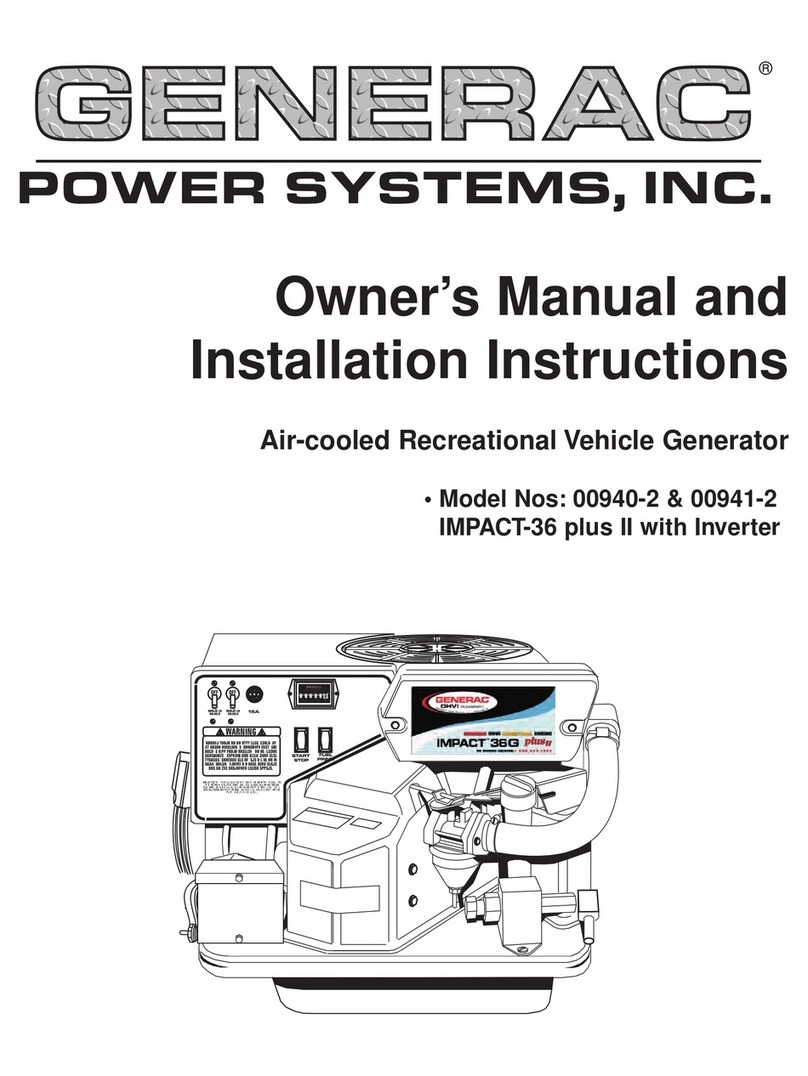
Generac Power Systems
Generac Power Systems 00940-2 Owner's manual and installation instructions
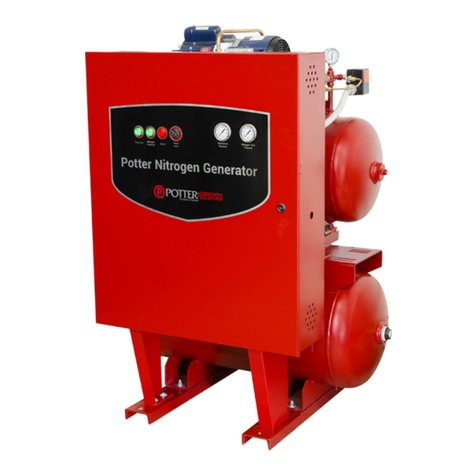
Potter
Potter NGP-1000D-M1 Installation, operation & service manual
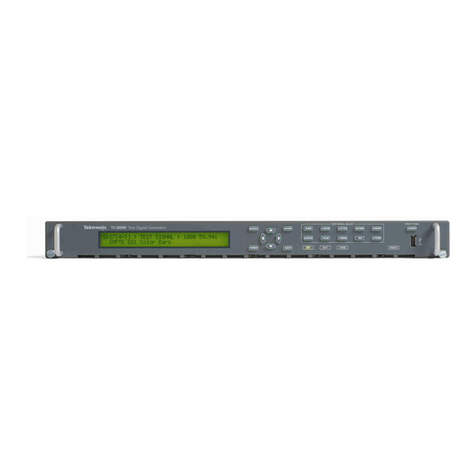
Tektronix
Tektronix TG8000 Technical reference
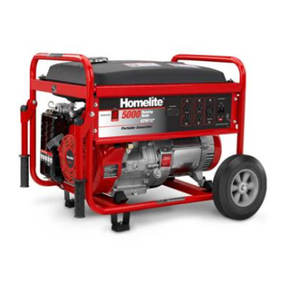
Homelite
Homelite HG5000 - REV 01 Operator's manual
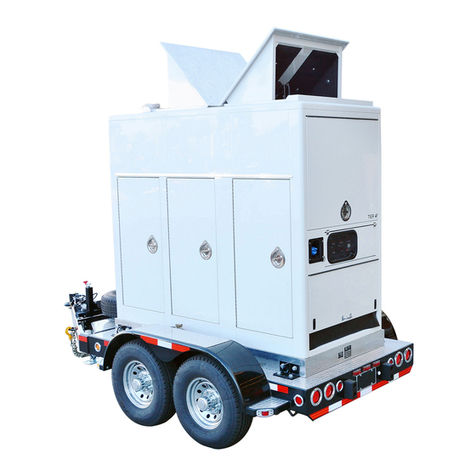
MULTIQUIP
MULTIQUIP MQ POWER SG1400C4F Operation manual
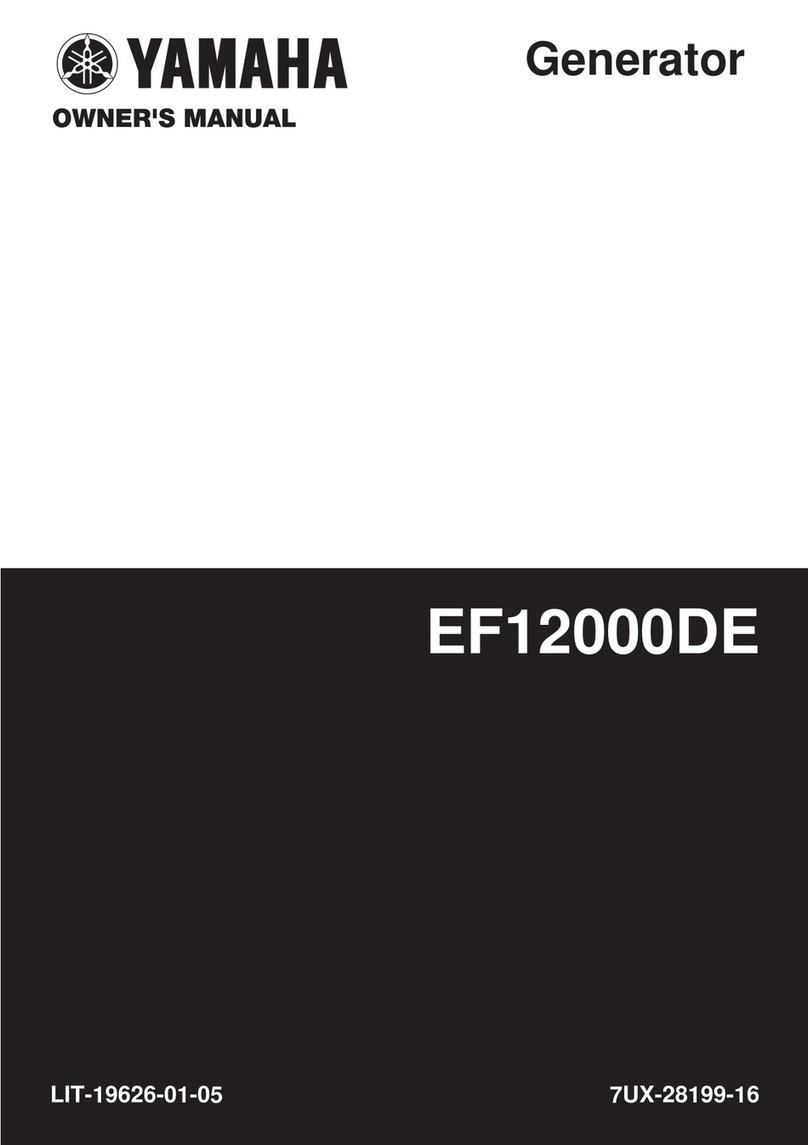
Yamaha
Yamaha EF12000DE - Premium Generator owner's manual
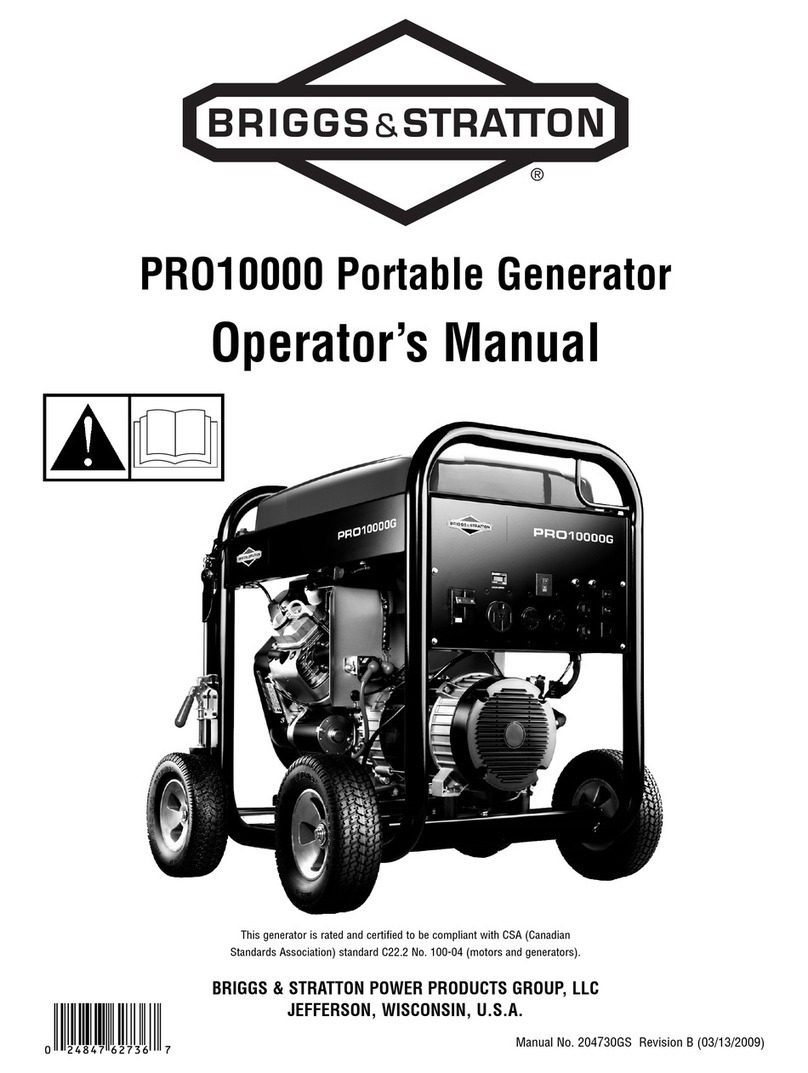
Briggs & Stratton
Briggs & Stratton PRO10000 030383 Operator's manual

REV Ritter
REV Ritter CSM24U instruction manual
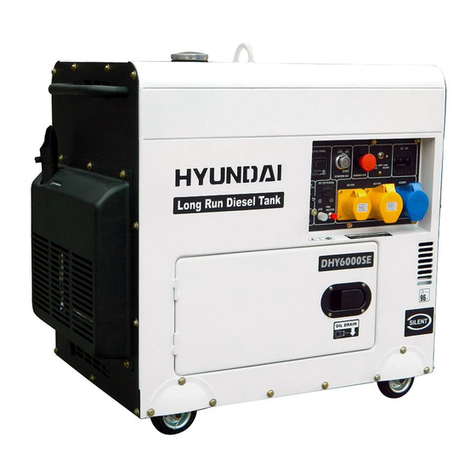
Hyundai
Hyundai DHY6000SE user manual
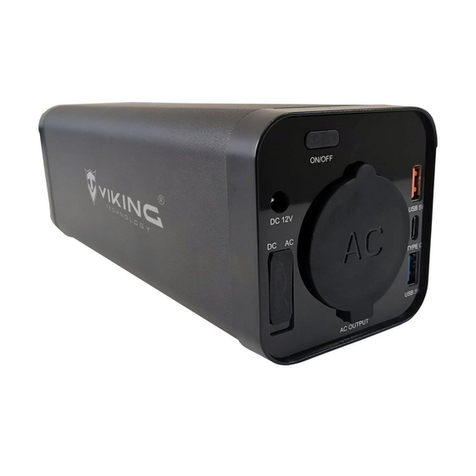
Viking Technology
Viking Technology UP200 user manual
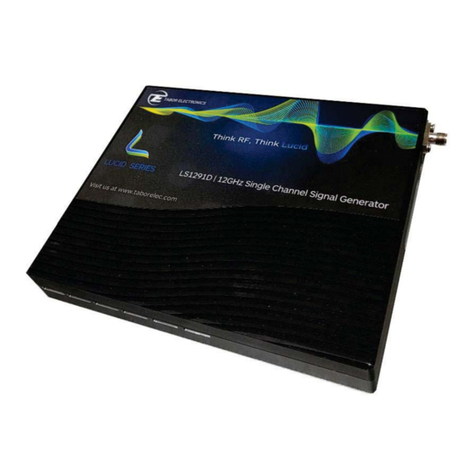
Tabor Electronics
Tabor Electronics Lucid Series user manual
